Indian economy and issues relating to planning, mobilization, of resources, growth, development and employment.
2.India’s ageing workforce
Context: An analysis of India’s workforce, sourced from Centre for Monitoring Indian Economy’s (CMIE’s) Economic Outlook data, shows that while India may be the country with the most youthful population, its workforce is rapidly ageing. In other words, the young are increasingly getting driven out of the job market.
Key details:
What is an ageing workforce?
An ageing workforce basically means that if one looks at all the employed people in India, the share of young people is going down while the share of those closer to 60 years of age is going up.
Definition of youth:
In CMIE’s data, youth is defined as those belonging to ages above 15 years and below 25 years.
Generally the workforce can be divided into three groups:
- Those aged 15 years or more but less than 30 years,
- Those aged 30 years or more but less than 45 years, and
- Those aged 45 years and older.

What the data shows?
- The data shows that the share of India’s youth has fallen from 25% in 2016-17 to just 17% at the end of the last financial year in March.
- Even the share of those in the middle group has fallen from 38% to 33% over the same period.
- The oldest age category however has grown its share from 37% to 49%.
- In other words, just in the past seven years, the workforce has aged so much that the share of people 45 years and older has gone from one-third to almost one-half.

- Data shows that while the total number of people with jobs has fallen from 41.27 crore to 40.58 crore, the biggest decline has happened in the involvement of India’s youth.
- In 2016-17, there were 10.34 crore people under the age of 30 years in the workforce.
- By the end of 2022-23, this number had fallen by over 3 crores to just 7.1 crore.
- At the same time, those aged 45 and above grew in numbers even though the overall employment levels fell.
Why is India’s workforce ageing?
- Even though its numbers are swelling up, the youth is getting driven out of the job market.
- A good way to track this is to look at the metric called “Employment Rate”.
- The Employment Rate (ER) for any population or age group tells us what proportion of that age group or population is employed.
- If there are 100 people in the ages 15 to 29 and only 10 are employed then the ER would be 10%.
- Fall in employment rate of the youth category:
- The population belonging to the youth category grew in size from 35.49 crore in 2016-17 to 38.13 crore in 2022-23.
- Yet the total number of people in this age group that had a job shows a secular decline.
- This is reflected in the sharp fall in the Employment Rate for this age-group.
- It fell from 29% to just 19%.
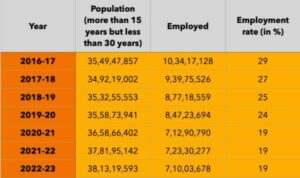
Employment rate of the middle age group:
Employment rate has also fallen for the next age category as well, albeit to a lesser extent.
Moreover, the employment rates in this age group were much higher to begin with.
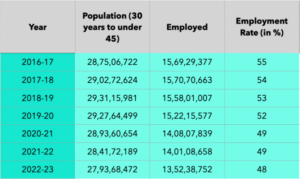
- Employment rate for older age group:
- The employment rates have declined the least for the oldest age group.
- This is the only age group where the absolute number of people with jobs has actually grown.
- It is another matter that the overall population of this cohort grew by even more and that is why the ER has fallen to some extent.
- Among the 45 years and above category, the age group of 55-59 years is the one that stands out.
- Not only is this cohort one of those rare ones that saw an increase in employment rate but is also the one which has registered the maximum increase in the ER over the past 7 years.
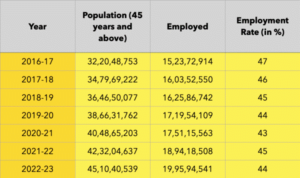
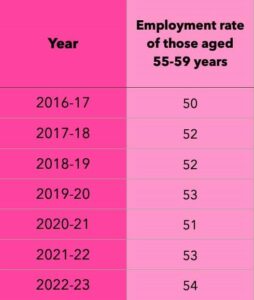
Concluding data:
- The age group of 25 to 29 years shows a rising employment rate over the past 7 years.
- But a look at the absolute numbers explains that the reason for this rise in ER is not that more people in this age group got a job, rather a sharp fall in the total population of this cohort.
- It is for this very reason that despite a better ER, this cohort is not able to pull up the numbers for the youth (15 to 29 years) category.
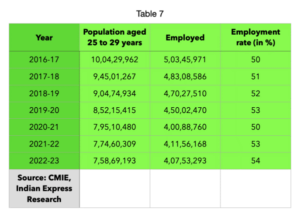
Way forward:
- The data clearly shows that even though India has a fast-growing youth population, that by itself does not guarantee more jobs for the youth.
- In fact, India’s workforce is rapidly ageing.
- That’s because the young are failing to make their mark in the job market and it appears they are increasingly getting elbowed out by the not-so-young Indians.
 Chinmaya IAS Academy – Current Affairs Chinmaya IAS Academy – Current Affairs
Chinmaya IAS Academy – Current Affairs Chinmaya IAS Academy – Current Affairs



